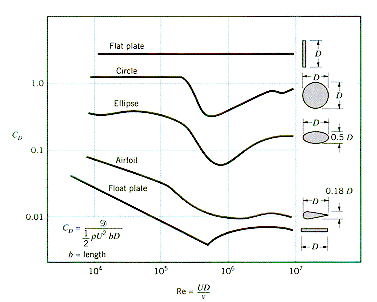| |
Drag
coefficients, CD, for several bluff and streamline shapes are shown
as a function of Reynolds number. The drag force, FD = CDA(rU2/2), depends directly
on this quantity.
For the flat plate normal to the flow, CD
is independent of Reynolds number over the range shown because flow
separation occurs at the sharp corners of the plate. When the plate is oriented
parallel to the flow direction the drag coefficient is reduced by more than
an order of magnitude and becomes Reynolds number dependent with transition
and turbulence causing CD to increase at higher Re.
It is
also seen that as a body changes its shape from a circular cross section to
an ellipse and then an airfoil the drag coefficient is reduced. Both the circle
and the ellipse show a rapid drop in CD at the onset of boundary
layer turbulence. Prior to this transition CD is not strongly
dependent on the Reynolds number. The airfoil shows a behavior closer to the
parallel flat plate. |
|
|
|
|
|
|
|
|
|
|
|
